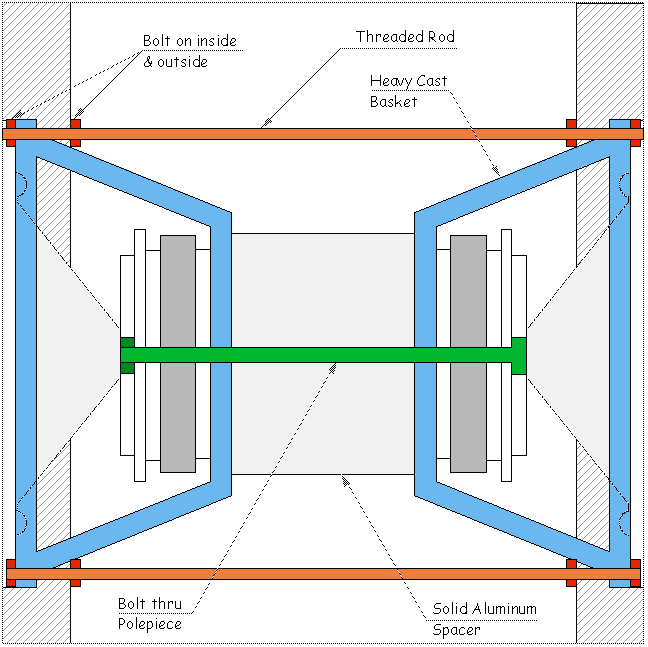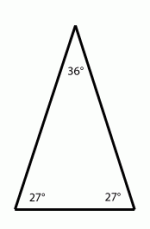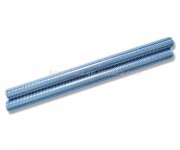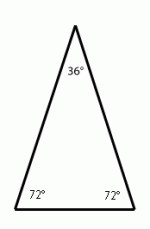Ray Collins said:John,
What is the brand and type of silicon you intended to use for bonding the constrained layer?
Ray
Ray,
I'm still going to use CLD. Just use the wedge scheme inside rather than the carpet I originally planned to use.
The silicone is GE silicone II clear. If you are familiar with this product, you'll know it sets to a semi-flexible rubber.
The intention is to have the outside panels cut, fit and ready. Apply beads (lines) of silicone about 1/2" apart to the back of the panel, then attach to the box. Using very little clamp pressure so that the panels will not be crushed together.
I forsee about a 1/16" layer of this silicone between the panels when done.
I'll take the time to do one side at a time, allowing the silicone to set before continuing to the next panel.
peterbrorsson said:
I've got a question about silicone. I have been using that before but gave up as it creeping out of joints long after its supposed to have dried. This was a problem particular when using paint on MDF. And above all, silicone and lacquer/paint are like republicans and democrates
Peter!,
Where have you been?
Silicone is unsuitable for perminent bonding of wood or wood products for all of the reasons you list: joint creep, paint incompatibilies.
The only two glues that I use for joining wood are either yellow carpenters glue or polyurethane glue.
The silicone is only for the CLD, where rigid attachment is not desirable.
The silicone is only for the CLD, where rigid attachment is not desirable.
Ok, I understand now what you use it for.
It's a shame because stronger and more airtight glue is hard to find. I tried to smash some old boxes which were joint glued with silicone. The only result was pain in my body and mdf broken. Joints were still intact.
Peter!,
Where have you been?
Well John, this topic went over my head completly after a while. No disrespect of you or Dave, but it does not matter for me if I know why/how/when something is percieved as better or worse. I choose what I like. I have enough of this analyzing at my work.
Cheers!
planet10 said:Something i have been encouraging people to try for some time... this one worked really well...
Looking at the cutaway and the rear view of the B&W enclosure you posted in #481 and #482:
1) The prisms seem to have a square base.
2) Not sure of the angles they cut to make the prisms but they look close to a golden triangle. "The golden triangle is an isosceles triangle such that the ratio of the hypotenuse to base is equal to the golden ratio." I've attached an image to approximate one, the angles are indicated in the drawing.
3) Nice how they integrated the front to back bracing in the molding of the rear.
Attachments
Another topic I'm coming in late to, and I'm not sure if this has been mentioned, but, along with using damping and bracing, I use threaded rods in my speakers occasionally. Using a couple of these along with washers and nuts inside and out of the cabinet will arrest just about any cabinet vibration.
Also, moving the inner nuts closer together (farther away from the outside of the cabinet) allows you to adjust the rigidity of the wood by flexing it taught.
You can make some interesting adjustments this way. Just my two cents.
(edited, for some reason my brain thought bolts = nuts this morning.)
Also, moving the inner nuts closer together (farther away from the outside of the cabinet) allows you to adjust the rigidity of the wood by flexing it taught.
You can make some interesting adjustments this way. Just my two cents.
(edited, for some reason my brain thought bolts = nuts this morning.)
Attachments
Moondog55 said:...spray the internal faces of those wedges with a soft rubbery coating...stays soft, and pliable...
MJL21193 said:Maybe, as Ted suggested, spraying with a damping material has some value for keeping the prisms themselves from vibrating as they disperse the sound energy...
Disclaimer: forgive the long post--not trying to make any point--just a dump of thoughts--might ramble a little--and include some:bs:--oh, there is a question at the end.
Trying to limit my thoughts to a sealed enclosure so this is all in the context of getting rid of the stuffing by providing a substitute for its good properties and tossing out the bad properties. Wish I had more experience in building and listening to the result. Most of that I have is in pro sound starting 30 years ago and our goal was mainly only reasonably low distortion but a lot of headroom for high amplitude when we needed it.
I've been reading about the big anechoic chambers and have learned that most of the damping effect in those comes from the conversion of sound energy into heat inside the wedges. Those wedges are usually made from material like fiberglass. I think that process includes refraction, and at different frequencies there would be varying multiple refractions. Refraction slows the sound energy as it passes through the material. Lower frequencies can pass through the wedge easier but after some time and thus refracting multiple times they would eventually lose their energy and be fully absorbed. All of the chambers I could find a description of had specs. that included a lower frequency cutoff, lower than that spec. and they were less effective. Main thought is that the wedge structures are huge in size comparison to the ones we're discussing in the thread. They don't reflect much energy, they're very lossy, so they either convert the energy the first time it passes into them or a little slower through refraction and multiple passes through multiple wedges.
Acoustic Test Chambers and Environments
Wikipedia Anechoic Chamber
Bell Labs Murray Hill Chamber
McIntosh Acechoic Chamber
With a dense wedge like the MDF prisms vs. the fiberglass ones, I think there is going to be a larger proportion of reflection of sound energy than refraction. MDF is way more lossless than fiberglass. Reflection changes the direction of the sound wave, like light in a mirror. Every time it is reflected there will be some energy converted to heat though because the MDF will absorb some energy through refraction like the fiberglass. With all that bouncing around there may be a risk of out of phase sound energy reaching the back of the cone but hopefully it will be very low in amplitude. I think the MDF will also have varying degree of effectiveness depending on the size of the wedge and the frequency of the sound energy striking the surface.
The trianglar cross section of the MDF wedge may count for something in distributing force that strikes it in the form of sound energy. Like rafters on a roof. I can't think of any percussion instruments that rely on vibration and resonances to produce sound (e.g. marimba or xylophone) that have trianglular cross sections. So maybe we're on a right track here. The tip might vibrate more than at the base. Think diving board. But probably that would be at high frequencies. Think of the elementary school trick of sliding a vibrating ruler across the edge of a table. As the end of the vibrating ruler gets "shorter" the sound goes up. These MDF shapes are fairly small so I'd bet the frequencies that would most cause a problem in exciting some resonance in the MDF are pretty high.
An absorbent coating, if it had the right properties, could increase refraction with the MDF wedges making them more lossy at certain frequencies. Given the small wedge size I think more lossy would work better if there was a problem in damping lower frequencies, but who knows.
I like thinking about this and imagining what will result. So, the "test" sealed enclosure has separate compartments. Low and Mid/High. I don't know the crossover design or what the room response is going to affect. Other than lowering distortion by damping the backwaves and changing box resonances with the added mass and bracing of the wedges, what are specific goals for each compartment separately? Or said in another way, what are the basic goals for a sealed enclosure given each frequency range--low, mid, high?
DoctorDyna said:I use threaded rods in my speakers occasionally. Using a couple of these along with washers and nuts inside and out of the cabinet will arrest just about any cabinet vibration.
Also, moving the inner nuts closer together (farther away from the outside of the cabinet) allows you to adjust the rigidity of the wood by flexing it taught.
This can be very effective. By stress loading the panels you are making them slightly curved and significantly increasing stiffness... it does take some effort to design around to get a stiff box... the threaded rod can also serve a dual function when used to bolt together the bezels of a push-push pair.
dave
planet10 said:... the threaded rod can also serve a dual function when used to bolt together the bezels of a push-push pair.
Smart thinking!!
panomaniac said:Smart thinking!!

http://www.t-linespeakers.org/FALL/push-push.html
The specific woofer also has the advantage of being designed to have a lag bolt put thru the pole piece to secure it to the cabinet.
dave
liasom said:
Refraction slows the sound energy as it passes through the material. Lower frequencies can pass through the wedge easier but after some time and thus refracting multiple times they would eventually lose their energy and be fully absorbed.
With a dense wedge like the MDF prisms vs. the fiberglass ones, I think there is going to be a larger proportion of reflection of sound energy than refraction. MDF is way more lossless than fiberglass. Reflection changes the direction of the sound wave, like light in a mirror. Every time it is reflected there will be some energy converted to heat though because the MDF will absorb some energy through refraction like the fiberglass. With all that bouncing around there may be a risk of out of phase sound energy reaching the back of the cone but hopefully it will be very low in amplitude. I think the MDF will also have varying degree of effectiveness depending on the size of the wedge and the frequency of the sound energy striking the surface.
Mike,
I think we should be looking at diffraction with this method rather than refraction. Refraction (for the most part) is what happens in a stuffed box.
I see the wedge structure as a means of dissipating the sound energy by having it bounce back and forth between the prisms planes, thereby both absorbing and diffracting the sound waves. Furthermore, placing the prisms perpendicular to each other, increases "breakup".
It's true that low frequencies will be virtually unaffected by this method, but the confines of the box are exceeded by these wavelengths, so nothing works in that case.
As I mentioned earlier, I tried my speaker with the interior untreated and it sounded quite good. This could be the overall shape coming into play, with the curved front and that it is deep but narrow. It still had the signature hollow sound in the low midrange though (mainly, I'd guess from the woofer chamber).
I'm hoping that the wedges eliminated that hollowness, as well as reduce standing waves.
I would be VERY put-off if after cutting and gluing all of the wedges, nothing is accomplished.
MJL21193 said:You're a regular push-push-pusher
That i am... so much benefit... so little effort.
dave
John,
Diffraction? Yes. I just hadn't gotten far enough to add that piece to my imagining. Over the weekend I was thinking on a level of a small number of simple waveforms interacting with different types of wedges. Wasn't trying to be negative about success, but did want to say that somewhere in all this is the possibility that the wedges may need to be designed to work--or more importantly NOT work--across a specific bandwidth. I have some ideas how to do that math, and I'm certain that solutions exist if they're needed. Basically just trying to dump my thoughts on the page in some sort of a coherent mess this morning.
Have fun cutting and gluing.
Diffraction? Yes. I just hadn't gotten far enough to add that piece to my imagining. Over the weekend I was thinking on a level of a small number of simple waveforms interacting with different types of wedges. Wasn't trying to be negative about success, but did want to say that somewhere in all this is the possibility that the wedges may need to be designed to work--or more importantly NOT work--across a specific bandwidth. I have some ideas how to do that math, and I'm certain that solutions exist if they're needed. Basically just trying to dump my thoughts on the page in some sort of a coherent mess this morning.
Have fun cutting and gluing.
liasom said:
...but did want to say that somewhere in all this is the possibility that the wedges may need to be designed to work--or more importantly NOT work--across a specific bandwidth. I have some ideas how to do that math, and I'm certain that solutions exist if they're needed.
Mike,
Don't want to waste my time doing something that doesn't have the desired effect. If you have the capacity to determine what the wedge geometry should be, I'd like to know about it.
Keep me from venturing blindly into the night...
My idea for the wedges is to have them of various sizes, to try to make them cover the broadest frequency range.
There is a practical limit to the amount that I can use in the boxes though. The current volume is 33 litres, pretty much optimal. Lose 3-4 litres is not much of a difference, but I really can't go hgher.
Any help / thoughts are welcome.
Another discussion on what to build speakers out of..
I know this sounds a bit off the wall but have you thought about using other materials other than wood based ones. Dibond is a thin aluminium sheet which comprises of two thin sheets of aluminium sandwiching a layer of polyetheylene. According to the manufacturers it has the same sound proofing properties of a piece of 20 mm thick plaster board. Dibond is approximately 3 mm thick and very light. Sandwich this between layers of ply or MDF or whatever chosen material you had in mind might have beneficial consequences................ on the other hand it might not................ I have not had an opportunity to try it out yet.
Just my two pennies worth.
I know this sounds a bit off the wall but have you thought about using other materials other than wood based ones. Dibond is a thin aluminium sheet which comprises of two thin sheets of aluminium sandwiching a layer of polyetheylene. According to the manufacturers it has the same sound proofing properties of a piece of 20 mm thick plaster board. Dibond is approximately 3 mm thick and very light. Sandwich this between layers of ply or MDF or whatever chosen material you had in mind might have beneficial consequences................ on the other hand it might not................ I have not had an opportunity to try it out yet.
Just my two pennies worth.
Re: Another discussion on what to build speakers out of..
Hi SteveT2,
This Dibond is a finished material for signs, right? It would keep me up all night if I wasted it between two layers of MDF. At $300 per sheet, it's too expensive for that purpose.
SteveT2 said:...Dibond is a thin aluminium sheet which comprises of two thin sheets of aluminium sandwiching a layer of polyetheylene. According to the manufacturers it has the same sound proofing properties of a piece of 20 mm thick plaster board. Dibond is approximately 3 mm thick and very light.
Hi SteveT2,
This Dibond is a finished material for signs, right? It would keep me up all night if I wasted it between two layers of MDF. At $300 per sheet, it's too expensive for that purpose.
I never said it was cheap!
Although I was surprised that it cost so much. Still, if you can afford it and you are trying to build a Reference speaker it might be something to consider. The front baffle of the speaker might be a place to start so as to reduce the thickness of it with its attendant problems of having to scoop out material on the back edge of the hole in order for the driver to breath.
Just a thought.
Although I was surprised that it cost so much. Still, if you can afford it and you are trying to build a Reference speaker it might be something to consider. The front baffle of the speaker might be a place to start so as to reduce the thickness of it with its attendant problems of having to scoop out material on the back edge of the hole in order for the driver to breath.
Just a thought.
John, my questions. - Mike
You stated there are two separate chambers in the 33 liter enclosure, correct? What is your estimate of the limit for the maximum height of the wedges in each? (this has to do with getting them through the hole and in glued in place more than anything else)
What are the basic specs for the 3-way crossover (xover points, slope)?
So I can understand more of what you hear. Your ear is telling you that there is a "hollowness" in the low-midrange bandwidth, if you were going to try to solve that with "traditional" methods what would you do first?
You stated there are two separate chambers in the 33 liter enclosure, correct? What is your estimate of the limit for the maximum height of the wedges in each? (this has to do with getting them through the hole and in glued in place more than anything else)
What are the basic specs for the 3-way crossover (xover points, slope)?
So I can understand more of what you hear. Your ear is telling you that there is a "hollowness" in the low-midrange bandwidth, if you were going to try to solve that with "traditional" methods what would you do first?
- Status
- This old topic is closed. If you want to reopen this topic, contact a moderator using the "Report Post" button.
- Home
- Design & Build
- Construction Tips
- Discussion on what materials to build speakers out of


